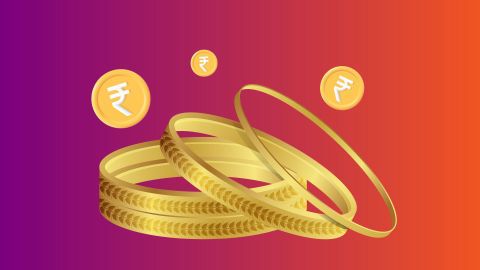The gold loan to value ratio (LTV) is an important factor in deciding how much money one can borrow against their gold. The Reserve Bank of India (RBI) sets strict rules to ensure that this process remains safe for both lenders and borrowers. As per gold loan LTV RBI guidelines, all banks and NBFCs in India can offer a maximum of 75% LTV for gold loan. This means if your gold is valued at Rs. 1,00,000, you can get a loan of up to Rs. 75,000. This cap helps avoid excessive lending and protects lenders from major losses in case of loan defaults.
NBFCs like Bajaj Finance offer flexible loan terms, but they still have to follow the gold loan LTV RBI limit. The LTV ratio for gold loan also affects how much interest you may pay—higher LTVs may come with slightly higher rates. The RBI keeps reviewing these norms to reflect changing market conditions.
Knowing the gold loan LTV helps borrowers plan better, negotiate wisely, and avoid borrowing more than they can repay. It also builds trust between the borrower and the lender. When you understand the gold loan to value ratio, you are better prepared to use your gold assets for immediate financial needs while staying within safe lending limits.
How do NBFCs determine the LTV ratio for gold loans?
NBFCs like Bajaj Finance determine the Loan-to-Value (LTV) ratio for gold loans based on guidelines issued by the Reserve Bank of India (RBI). As per current RBI regulations, the maximum LTV ratio allowed is up to 75% of the gold’s market value. This means if your gold is valued at Rs. 1,00,000, you may get a loan of up to Rs. 75,000.
The gold’s value is assessed based on its purity (usually 18 to 22 karats), weight, and the prevailing gold market price. Only the actual gold content is considered, stones and other embellishments are excluded. The final loan amount depends on this calculated value and the applicable LTV ratio.
NBFCs like Bajaj Finance ensure transparency in gold valuation and follow a standardised process. This helps borrowers know exactly how much loan they can get. The LTV ratio also helps maintain a balance between borrower benefit and lender risk, ensuring responsible lending practices.
How to calculate the loan-to-value ratio in gold loans?
The Loan-to-Value (LTV) ratio is an essential metric in determining how much loan you can get against your gold. This helps both borrowers and lenders assess the maximum eligible loan amount.
To calculate the LTV ratio, follow these steps:
- Determine the market value of the gold jewellery based on:
- Net weight of the gold (in grams)
- Purity level (for example, 22 Karat)
- Current market price of gold per gram
- Use the formula:
LTV Ratio (%) = (Loan Amount / Market Value of Gold) × 100
Example calculation:
- Weight of gold pledged: 50 grams
- Purity: 22 Karat
- Market price: Rs. 5,000 per gram
- Total gold value = 50 × Rs. 5,000 = Rs. 2,50,000
- Loan offered: Rs. 1,87,500
- LTV Ratio = (Rs. 1,87,500 / Rs. 2,50,000) × 100 = 75%
This means the lender is offering 75% of the gold’s value as a loan, which is a common industry standard.
Maximum LTV ratio allowed for gold loans
The maximum LTV ratio allowed for gold loans in India, as per the RBI guidelines, is 75%. This regulation applies to both banks and NBFCs. Lenders can provide a loan amount of up to 75% of the gold's market value, safeguarding the interests of both parties involved. The purpose behind setting this limit is to mitigate the risk of borrowers defaulting on their loans and to ensure the safety of the financial institutions. While this is the maximum allowable ratio, some lenders may offer lower LTVs depending on their internal risk assessment policies and borrower profiles.
Impact of LTV on gold loan amount
The Loan-to-Value (LTV) ratio plays a crucial role in determining how much loan you can receive against your pledged gold. A higher LTV ratio means more funds, but it also affects your repayment terms.
- A higher LTV ratio allows you to borrow a larger amount for the same value of gold.
- For instance, with an LTV of 75%, gold worth Rs. 1,00,000 can fetch a loan of Rs. 75,000.
- If the LTV ratio is lower, like 60%, the loan amount would reduce to Rs. 60,000 for the same gold value.
- Higher LTV offers quicker financial relief in urgent situations.
- However, it may come with increased interest rates and stricter repayment conditions.
- Borrowers should assess both the loan amount and associated terms before opting for a high LTV gold loan.
In conclusion, while a higher LTV ratio boosts borrowing power, it is important to consider the long-term repayment impact and overall cost of the loan.
Gold loan-to-value ratio calculation
To calculate the gold loan-to-value ratio, the first step is to evaluate the purity and weight of the pledged gold, followed by determining its current market value. The LTV ratio is then computed by dividing the loan amount by the market value of the gold and multiplying the result by 100. For instance, if the gold is worth Rs. 2,00,000 and the lender offers a loan of Rs. 1,50,000, the LTV ratio would be (Rs. 1,50,000/Rs. 2,00,000) * 100 = 75%. This calculation is essential for both borrowers and lenders to assess the value of the loan concerning the pledged gold.
Factors affecting LTV ratio in gold loans
Several factors influence the LTV ratio in gold loans:
- - Gold purity: Higher purity gold, such as 22-karat or 24-karat, typically allows for a higher loan-to-value (LTV) ratio, as it has a greater intrinsic value.
- - Market price of gold: Fluctuations in the market price of gold directly impact the LTV ratio. Higher gold prices may increase the amount lenders are willing to offer.
- - Lender’s policy: Different lenders have varying LTV policies based on risk appetite. Some may cap the LTV ratio lower to minimise risk exposure.
- - Regulatory limits: The Reserve Bank of India (RBI) caps the maximum LTV ratio for gold loans, generally around 75%, ensuring lenders maintain a buffer against price volatility.
- - Type of borrower: Lenders may assess the borrower’s credit profile and financial stability, potentially adjusting the LTV ratio based on creditworthiness.
- - Loan tenure: Shorter loan tenures may allow for a higher LTV ratio, as lenders face less risk over a shorter period.
- - Gold loan product type: Different loan products, such as overdraft or term loans, may have varying LTV ratios based on structure and repayment terms.
- - Demand for gold loans: High demand for gold loans in certain regions or periods can influence the LTV ratio as lenders adjust terms to stay competitive.
Why is the LTV ratio important in gold loans?
The Loan-to-Value (LTV) ratio plays a key role in determining the loan amount you can get against your gold. Here are some important points to consider:
- The LTV ratio determines how much loan a borrower can avail based on the market value of their gold.
- A higher LTV ratio means a borrower can receive a larger loan amount for the same value of gold.
- A lower LTV ratio helps reduce the lender’s risk, maintaining financial stability.
- The balance between high and low LTV ensures sustainable lending for both borrowers and lenders.
- LTV ratio directly affects interest rates — higher LTVs may come with slightly higher interest charges.
- Being aware of the LTV ratio helps borrowers make informed decisions and plan repayments better.
Understanding how the LTV ratio works allows you to negotiate better terms and manage your gold loan more efficiently.
Loan to value ratio for gold loan: How it works?
- The loan-to-value (LTV) ratio in gold loans works by determining the percentage of a loan offered based on the value of the gold pledged. For instance, if a borrower pledges gold worth Rs. 1,00,000 and the lender offers an LTV of 75%, the borrower will receive Rs. 75,000 as a loan. This ratio ensures that the lender’s risk is balanced with the borrower’s needs. The higher the LTV, the greater the loan amount, but the interest rate and repayment terms may become more stringent. Borrowers should assess their financial needs and repayment capacity when opting for a gold loan based on the LTV ratio.
- As per RBI guidelines, Bajaj Finance offers LTV of up to 75% of your gold’s value as loan amount. With a loan amount starting from Rs. 5,000 to Rs. 2 crore, you can also benefit from features like free insurance of gold, multiple repayment options, no prepayment charges, and more, making it a wise financing option.






